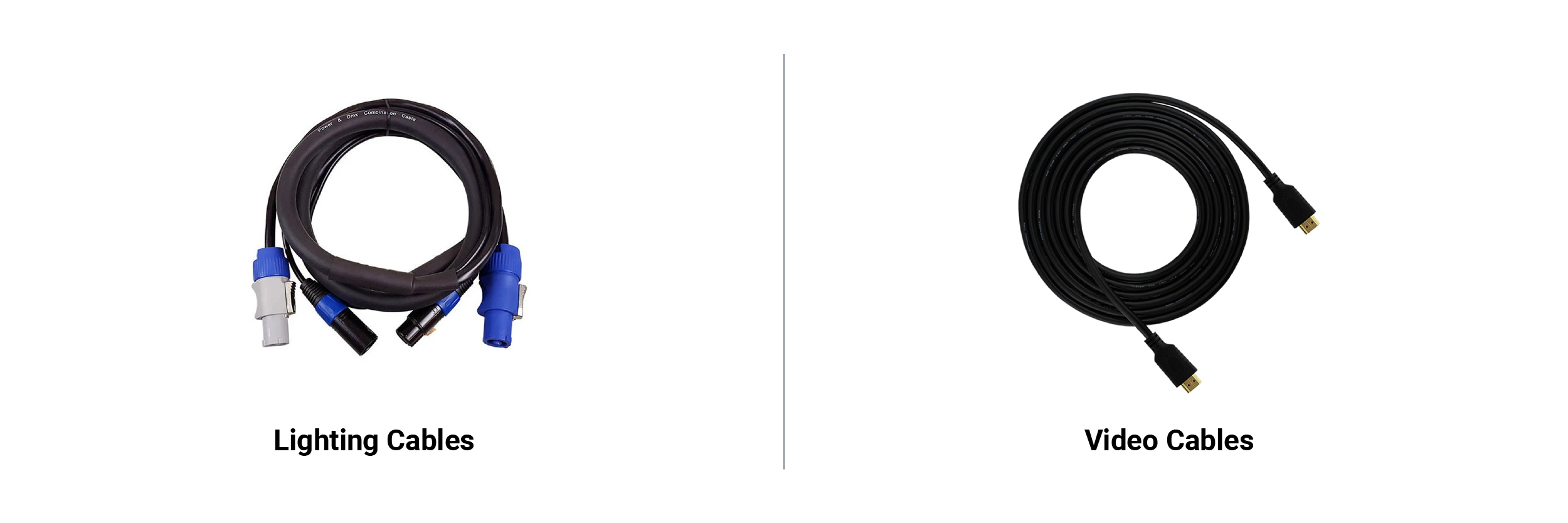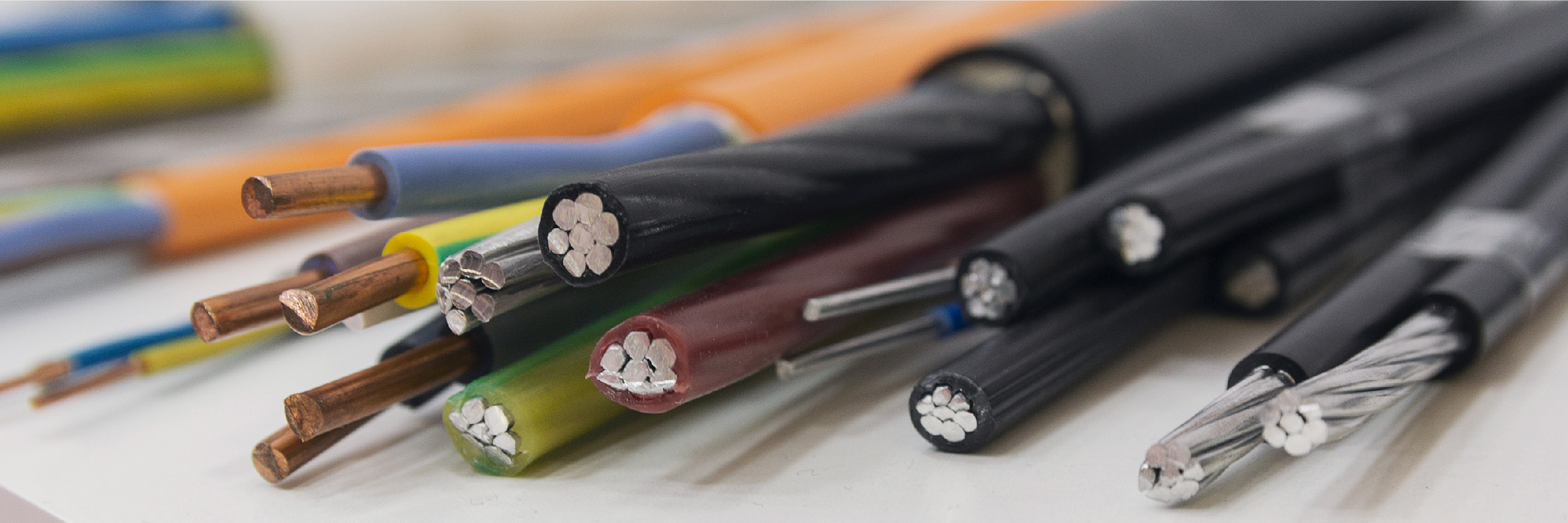The Care and Keeping of Cables
Posted by Laura Strommen - SoundPro on Dec 16th 2022
Estimated Reading Time: 12 Minutes
Cables are an underappreciated yet essential part of any audio, visual, or lighting setup. You can buy the finest gear available, but if it’s connected to a cable that doesn’t properly transmit a signal, the results will disappoint. Avoid this scenario, connect with confidence, and enhance your gear’s performance when you pair your AVL gear with cables that will optimize the signal and give you the best results.
Anywhere you have an AVL setup will likely utilize a variety of cable types that connect you to audio sources, video equipment, and light fixtures. Cables can make or break the success of the AVL experience.
THE TYPICAL ANATOMY OF A CABLE
Inside a cable are layers of delicate materials that work together to ensure your electronic signal gets to where you need it to go.
1. At the center’s cable is a core (or conductor) of conductive signal wire or wires. This core transmits electronic signals from an input source to an output source—for example, an electric guitar to a loudspeaker.
2. The core is generally encased in an electrostatic shield of rubber or other insulating material.
3. Next comes a layer of shielding comprised of braided wires or foil. Shielding protects the signal and prevents handling noise, shorts, and other bad things you don’t want to happen when using your electronics.
4. Around this shielding is the outer jacket of the cable.
While this configuration describes the most common way a cable’s cross-section is laid out, other cables, such as those Ethernet, share the same basic parts but may be assembled in a different configuration so the cross-section looks different.
The Importance of Proper Cable Care
Cables are designed to lay and coil in a certain way that preserves the cable interior and keeps the cable working its best. This natural coil of the cable is called its memory. Unfortunately, poor handling and storage can train this memory over time, eventually ruining the cable.
While it’s important to properly care for all types of cables, certain cables are less forgiving than others when it comes to being improperly wrapped. If a cable is thicker (as is common with audio snakes) or simply has a less flexible outer jacket (such as in a coaxial cable), its memory may be more rigid. While it might be harder to cause kinks in these more robust cables, whatever kinks they accumulate will be difficult—if not impossible—to correct this problem…meaning that sometimes all it takes is one mistake to ruin a cable setup beyond repair.

COMMON AVL CABLE TYPES
Sound Productions offers a vast selection of cables, snakes, and more to meet your project’s needs. Below is an outline of some of the more basic cable types, but we also carry cables for A/C, Insert/Y, MIDI, Balanced and Unbalanced audio cables, and more, as well as accessories, connectors, and adapters to further customize your connectivity.
Audio Cables
Instrument cables are used to connect electronic instruments such as guitars, basses, keyboards, and drum kits to speakers, amplifiers, or mixers. Musicians who take pride in the quality of their instruments will want to invest in a cable that accurately reflects this quality.
- ProCo EG 1/4 TS Instrument Cable
- ProCo EGL 1/4 TS to Right Angle Instrument Cable
- RapcoHorizon SG1 Guitar Cable
- Shure WA302 Instrument Cable
Whether you’re a singer, speaker, musician, or anyone else capturing audio for live or recorded productions, likely a microphone is central to your setup. Do your sound justice with microphone cables that faithfully transmit every detail and nuance.
- CBI MLNQ Studio Quad Microphone Cable
- Mogami GOLD-STUDIO Superflexible Microphone Cable
- RapcoHorizon NM1 Microphone Cable
- RapcoHorizon NM5 Microphone Cable
- Whirlwind Quad MKQ Microphone Cable
Speakers are essential for achieving an immersive sound experience for live shows, recording studios, audio editing, and more. Because of this, speaker cables are crucial to ensuring your speakers work their best.
- RapcoHorizon SP4 Neutrik Speak-On Speaker Cable
- Rapco-Horizon H14-N4N4 14 AWG Speaker Cable
- Rapco-Horizon CM-12/4.K 500-Foot Bulk Speaker Cable
- RapcoHorizon H14 14GA 1/4 TS Speaker Cable
- West Penn 25291B Shielded Audio Cable
Lighting Cables
When it comes to cables for lighting, choose from XLR, DMX, etherCON, and more, as well as extension cords to spread out your lighting setup across a larger space.
- Io Audio Technologies Professional A-B Powerlatch Cable
- Accu-Cable AC3CDMX300 3-Pin Conductor DMX Cable
- Blizzard DMX5PC Cool Cables DMX 5-Pin PC Combo Cable
- Hosa XLR3M to XLR3F DMX Cable
- Blizzard Powercon to Powercon Cable
Video Cables
Video signals are constant and require consistency, reliability, and accuracy in their transmission. That’s where video cables come in, offering quality and durability that allow you to record or broadcast your images with confidence.
- C2G Thunderbolt 3 Cable
- Hosa USB-306AB Type A to B SuperSpeed USB 3.0 Cable
- Hosa USB-306CA SuperSpeed USB 3.0 Cable
- Hosa USB-306CC SuperSpeed USB 3.1 (Gen2) Cable
- ProCo StageMaster HDMI Cable

HOW TO TAKE CARE OF YOUR CABLES
No matter how many or what kind you use, proper care ensures you get the most out of your cable system, prolonging its lifespan and helping it stay at optimal performance—thus making the most of your investment in high-quality cables.
How To Clean Electronic Cables
As electronic components, it’s a good rule of thumb to keep cables away from liquid. Wiping the length of a cable with a microfiber cloth is usually all that’s needed to keep it free of dust. However, if a cable gets dirtier and needs better cleaning, unplug the cable, and then use a slightly damp cloth to clean it. Immediately remove any excess moisture with a dry cloth before reconnecting the cable to any power supply.
HOW TO WRAP A CABLE
Unlike other AVL gear that’s possibly most sensitive when it’s being cleaned, the real challenge when it comes to cable maintenance is its storage: specifically, cable wrapping (sometimes called “cord wrapping”). A distorted cable—the consequence of improper wrapping—causes kinks that damage the interior wires and shielding, which harms the cable’s performance and longevity.
The key to a good cable wrap is a result that lets you instantly uncoil the cables when you need to. A properly wrapped cable will lay straight—without any hills or loops, kinks, or tangles. (This is beneficial not only for the cable itself but also for stage managers or studio producers looking to minimize tripping hazards.)
The goal of any properly wrapped cable is to have
a) Loops that are all approximately the same size--not only does this look better, but it will also help you handle the coil and store it neatly
b) No kinks, tangles, or knots
Another clue that a cable is being properly maintained is that it passes the “throw” test. Let’s say you have a coil of cable that’s 25 feet long, and you need it to stretch its full length across the stage. Assuming there’s nothing (and nobody) in your way, you should be able to throw one end of the cable in front of you, and it should uncoil until it’s laid in a straight line across the stage.
When you deal with cables, you’re usually in a hurry and want to wrap things up...literally. But the reality is that when you are dealing with cables, you’ll either spend some extra time wrapping them correctly or spend a lot of time untangling your cables the next time you go to use them. Therefore, although it may be more time-consuming at first, think of this proper cable wrapping method as an investment in your future—one that will pay off with longer-lasting cables.
The Wrong Way to Wrap Cables
Often when you see someone wrapping a cable, they’re using their arm as a sort of spool, using their free hand to wrap the cable tightly from wrist to elbow. This is commonly called “The Elbow Wrap,” and it is WRONG. Think of it this way: “Elbow” starts with E, which stands for Evil.
The Elbow Wrap twists the cable, causing kinks in the interior of the cable that you may or may not be able to see, but which will negatively affect the cable’s performance and longevity. Incorrectly wrapped cables snag, get knots, and tangles. These things are not only a pain to straighten out to prevent tripping hazards or make your cable stretch to its proper length, but these kinks cause the cable’s inner shielding to open, diminishing or even ruining the cable’s ability to do its job.
Other cable wrapping methods include the “Over-Over Wrap,” where you handle the cable more gently to create loops. Although this method causes fewer kinks and does a better job of prolonging the cable’s performance life, it creates a “spiral” in the interior of the cable, straining the same points of the core every time you use this wrapping method.
It’s about helping you take the best care of your cables. And there simply is only one method of wrapping that does that: the “Over-Under Wrap.”
The Right Way to Wrap a Cable
Also known as the lariat, electrician, or cable wrap, the Over-Under Wrap works to alleviate stress on the cable interior by alternating between two methods of creating a loop of cable. The result is a coil that lets you instantly unravel it when you need it, without encountering snags or knots.
1. Getting Started
Hold one end of the cable in your left hand. The long end of the cable should lay over the top of your fingers, with your thumb holding the end in place. (You’ll be manipulating this long end with your right hand to create the coil.) However, these directions are ambidextrous; you can switch which hand accomplishes each role depending on what’s comfortable.
2. Loop A
Holding the long end with your right hand, smooth and straighten it gently. Half-turn the cable with your right hand until it begins to form a loop. Place this in your left hand.
3. Loop B
This is the tricky part. You don’t want to twist again because that will cause the coil to be too tightly spiraled, which will cause the same pressure to be put in the same places along the full length of the cable. (This is what happens when using the Over-Over Wrap.) Instead, you want to reverse the tension so that it comes out “even” by turning the cable in on itself.
Once again, run your right hand out, smoothing and straightening the cable, holding it between your fingers and thumb. Your fingers and palm should be facing down. Pivot your hand so it’s facing palm up; this should result in a loop in the cable. Pass that over to your left hand.
Alternate between Loops A and B for the full length of the cable. To achieve the same size of loops, always draw out the next portion of the cable to approximately the same length. It’s okay to eyeball it, but you’ll probably have to pay attention to this at least when you’re first getting used to this proper method until you get a feel for it. Once you get used to it, this proper cable wrap won’t take any more time or thought to do than the Elbow Wrap atrocity.
If you are dealing with older cables that have been improperly wrapped in the past, you may notice they have an affected memory that doesn’t seem to let you naturally create an A or B loop. In this case, it’s okay to repeat the previous loop method (for instance, putting two Loop As in a row, then compensating with two Loop Bs to get back on track). However, try not to do this often, or it will ultimately defeat the purpose of proper coiling. After improper use, some cables simply are not capable of being wrapped properly, while others may get their memories “reformed” by continuing to wrap them as correctly as possible.

OTHER ASPECTS OF CABLE MAINTENANCE
Now that you have the cable coiled properly, you’ll want to secure it so your work doesn’t inadvertently unravel during handling or storage. Do not use the end of the cable to secure the coil; this won’t be secure and will cause terrible kinks at the cable’s end! Instead, use one or more cable ties to secure everything in place.
Cable ties (or cable straps) are usually soft and attach via Velcro, so they won’t scratch the cable exteriors themselves. Attach to one end of the cable, then wrap it around the cable; this will have the added benefit that the tie won’t get misplaced while you’re using the cable.
To help take the hassle out of your cable management, Sound Productions carries a wide range of ties, tape, organizers, and other accessories, including:
- Hosa CBT-500 Audio Cable Tester
- Hosa WTI-508 Black Hook and Loop
- Mackie MTEST-1 7-in-1 Cable Tester
- Pro Tapes 2-Inch x 55 Yard ProGaff Gaffer's Cloth Tape
Minimize the need for cleaning and other maintenance by taking preventive measures. When you’re not using a particular cable, store it in a gear bag, drawer, or other enclosed space to protect it from dust, humidity, temperature changes, and other environmental factors. To ensure your cables continue to work at peak performance, use a cable tester during regularly scheduled maintenance and before you connect them to your other gear. By taking the extra effort to care for your cables, you ensure they deliver the best quality so that your AVL gear performs better, longer, and more reliably.
For more information on the care and keeping of cables, or if you’re in the market to upgrade or outfit your setup with new cables, snakes, or connectors, reach out to the SoundPro experts at info@soundpro.com or 800.203.5611.

Laura Strommen - Web Content Specialist
Laura earned a BA in English at the University of Wisconsin – Whitewater and has over five years of experience as a content writer and copy editor. She’s been part of the SoundPro team since 2021.

